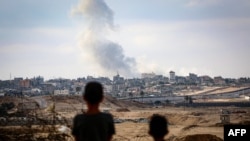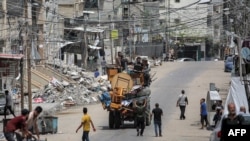Israeli forces battled Hamas militants Monday in northern and southern Gaza, while the Gaza Health Ministry warned a shortage of fuel needed to operate hospital generators and ambulances has pushed the medical system to the brink of collapse.
Witnesses reported fighting in the Jabalia refugee camp in northern Gaza, part of an area Israeli troops have returned to to battle what the military says is an attempt by Hamas to regroup.
Residents also reported intensified aerial and ground attacks in Rafah, near the Gaza-Egypt border.
The U.S. State Department said late Sunday that Secretary of State Antony Blinken discussed “U.S. opposition to a major military ground operation in Rafah” as he spoke by telephone with Israeli Defense Minister Yoav Gallant.
The statement said Blinken also reaffirmed U.S. commitment to “the shared objective of the defeat of Hamas,” while also highlighting the need to protect civilians and urging Gallant to “help address distribution challenges inside of Gaza as Israel pursues Hamas targets.”
About 300,000 of the 1.3 million Palestinians who fled to southern Gaza months ago on orders from the Israeli military to escape the attacks on Hamas militants in northern Gaza have now been ordered to move again, this time to the northwest of Rafah, to an area along Gaza’s Mediterranean Sea coastline.
U.N. human rights chief Volker Turk said Sunday the ongoing fighting and the evacuation orders brought “massive displacement of an already profoundly traumatized population.”
Turk questioned where people should go in Gaza, saying there is “no safe place.”
“I have repeatedly expressed my alarm about the catastrophic impact of a possible full-scale offensive on Rafah, including the possibility of further atrocity crimes,” Turk said. “I can see no way that the latest evacuation orders, much less a full assault, in an area with an extremely dense presence of civilians, can be reconciled with the binding requirements of international humanitarian law and with the two sets of binding provisional measures ordered by the International Court of Justice.”
Earlier Sunday, Blinken told NBC’s “Meet the Press” show there is no specific Israeli plan to protect the Palestinians or provide sufficient humanitarian aid for them.
“There's something else that's important,” Blinken said. “We also haven't seen a plan for what happens the day after this war in Gaza ends. Because right now, the trajectory that Israel is on is even if it goes in and takes heavy action in Rafah, there will still be thousands of armed Hamas left.”
The top U.S. diplomat said, “We've seen in areas that Israel has cleared in the north, even in Khan Younis, Hamas coming back.”
“So, the trajectory right now is that (Israel) going into Rafah, even to deal with these remaining (four) battalions, especially in the absence of a plan for civilians, risks doing terrible harm to civilians and not solving the problem, a problem that both of us want to solve, which is making sure Hamas cannot again, govern Gaza,” Blinken said.
The U.S., Israel’s chief arms supplier, has repeatedly warned Israel against a full-scale ground offensive into Rafah but the Israel Defense Forces have continued an aerial bombardment and more limited ground assaults.
U.S. President Joe Biden has paused shipment of 3,500 227-kilogram and 907-kilogram bombs to Israel out of concern they could be used in an attack on Rafah.
In addition, Biden said last week that he would halt sending some other offensive weapons to Israel if it launches a full-scale Rafah offensive.
Israeli talks with Hamas for a cease-fire and the release of 100 or so hostages Hamas is still holding have stalled, while Israeli Prime Minister Benjamin Netanyahu has repeatedly said his country will not end the war until it roots out the remaining Hamas militants in Rafah.
Blinken warned of the ongoing chaos.
“Israel is on the trajectory potentially, to inherit an insurgency with many armed Hamas left or if it leaves a vacuum, filled by chaos, filled by anarchy and probably refilled by Hamas,” he said. “We've been talking to them about a much better way of getting an enduring result, enduring security, both in Gaza itself and much more broadly in the region.”
Blinken said, “The quickest way for this to end is for Hamas to give up the hostages. We will get a cease-fire that we can build on and build to something more lasting and more durable. The different teams continue to talk.”
“It would also be the best way to make sure that we can really surge humanitarian assistance and better protect civilians in Gaza,” he said. “Hamas purports to be interested in that. Its actions certainly demonstrate the opposite.”
On Sunday, the U.S. political divide over American policies related to Gaza was readily apparent.
Progressive independent Senator Bernie Sanders, who aligns with Democratic opposition to Israel’s conduct of the war, told NBC that Israel should "not be receiving another nickel in U.S. military aid. Israel has ... gone to war against the entire Palestinian people, and the results have been absolutely catastrophic."
Republican Senator Lindsey Graham compared the Israel-Hamas war to World War II, telling NBC, “Why did we drop two ... nuclear bombs on Hiroshima and Nagasaki? To end a war we couldn’t afford to lose. ... That was the right decision. ... Israel, do whatever you have to do to survive as a Jewish state.”
On the battlefield, aside from attacks on Rafah, Israel bombarded the urban Jabaliya refugee camp and other areas in northern Gaza. The region has suffered widespread devastation and been largely isolated by Israeli forces for months. United Nations officials say there is a "full-blown famine" there.
Residents said Israeli warplanes and artillery struck across the camp and the Zeitoun area east of Gaza City, where troops have battled militants for more than a week.
The war was triggered by the October 7 Hamas attack on Israel that killed 1,200 people and led to the capture of about 250 hostages according to Israeli officials. Israel’s subsequent counter-offensive in Gaza has killed more than 35,000 Palestinians, according to the Gaza Health Ministry, which includes civilians and combatants in its count but says the majority of the dead are women and children.
Some material in this report came from The Associated Press, Agence France-Presse and Reuters.









